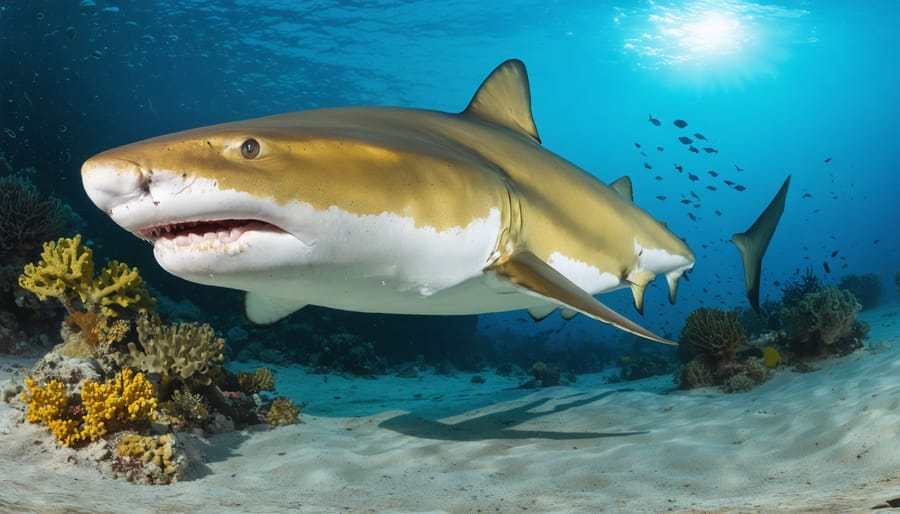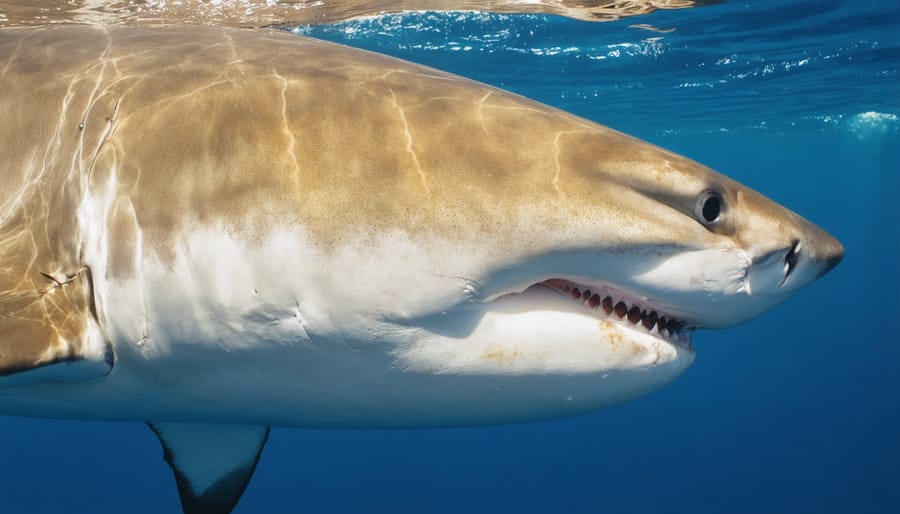
In the complex tapestry of marine ecosystems, the lemon shark stands as a masterful architect of oceanic balance. These remarkable predators shape coastal environments through intricate behavioral patterns and feeding relationships that extend far beyond their role as apex hunters. From mangrove nurseries to coral reef systems, lemon sharks regulate prey populations, maintain species diversity, and contribute to the health of seagrass beds through their movement patterns. Their presence indicates the vitality of coastal ecosystems, while their hunting behaviors create a cascade of effects that influence everything from fish population dynamics to the distribution of marine vegetation. Understanding their ecosystem roles has become increasingly crucial as marine biologists and conservationists work to protect these essential predators and the delicate coastal environments they help maintain. Through decades of research and observation, we’ve discovered that these sharks are not just predators, but rather ecosystem engineers whose presence or absence can fundamentally alter marine community structures.
Key Anatomical Features That Define Ecosystem Impact
Sensory Adaptations
Lemon sharks possess remarkable electroreceptors and sensory adaptations that make them highly effective predators in their ecosystem. Their most distinctive feature is the ampullae of Lorenzini, specialized organs that detect minute electrical fields produced by prey hidden in the seafloor. These electroreceptors are particularly concentrated around their snout, allowing them to locate prey even when visibility is poor.
The lateral line system, running along both sides of their body, enables lemon sharks to detect subtle water movements and vibrations from considerable distances. This sensory system helps them track moving prey and navigate through complex reef environments, especially during nighttime hunting.
Their excellent vision, enhanced by a reflective layer called the tapetum lucidum, allows them to see clearly in low-light conditions. Combined with highly developed olfactory organs that can detect blood from great distances, these sensory adaptations make lemon sharks perfectly equipped for their role as mid-level predators in coastal ecosystems.
These sophisticated sensory systems not only aid in hunting but also play crucial roles in social behavior, navigation, and avoiding potential predators during their juvenile stages.

Physical Characteristics
Lemon sharks possess distinct physical characteristics that perfectly suit their roles within coastal ecosystems. These sharks typically grow to lengths of 10-11 feet, with females generally being larger than males. Their yellowish-brown coloration serves as excellent camouflage against sandy seafloors, allowing them to be effective ambush predators in shallow waters.
The species features a stocky, robust body shape with two dorsal fins of nearly equal size, which provides exceptional stability while hunting in complex reef environments. Their broad, flattened head houses highly developed ampullae of Lorenzini, enabling them to detect the electrical signals of prey hidden in sediment.
Perhaps their most notable feature is their relatively small, sharp teeth, designed for grasping rather than tearing. This adaptation reflects their feeding strategy, focusing on smaller fish and crustaceans rather than larger prey. Their muscular bodies and powerful tails allow them to maneuver efficiently in shallow waters, making them well-suited for patrolling seagrass beds and mangrove forests.
These physical traits not only enhance their survival capabilities but also influence their role as intermediate predators in tropical marine food webs.
Predator-Prey Relationships
Hunting Mechanisms
Lemon sharks possess remarkable hunting adaptations that have evolved to maximize their success as predatory species. Their distinctive jaw structure features a robust skeletal framework that enables powerful biting force, essential for capturing and securing prey. The arrangement of their teeth is particularly noteworthy, with multiple rows of triangular, serrated teeth that are ideally suited for grasping and tearing prey.
These sharks exhibit a unique teeth configuration where replacement teeth lie in wait behind the functional front row, ensuring continuous hunting efficiency even when teeth are lost during feeding. Their dental structure allows them to effectively handle a diverse range of prey, from fish and crustaceans to smaller marine mammals.
Their swimming capabilities further enhance their hunting prowess. Lemon sharks possess strong, streamlined bodies with large pectoral fins that provide exceptional maneuverability in shallow coastal waters. They can maintain a steady cruising speed while expending minimal energy, making them efficient hunters over extended periods. Their ability to make sharp turns and quick accelerations is particularly advantageous when pursuing agile prey in complex reef environments.
The combination of these physical attributes enables lemon sharks to maintain their crucial role as mid-level predators in coastal ecosystems, helping to regulate prey populations and maintain ecological balance.

Prey Selection Impact
The lemon shark’s unique anatomical features play a crucial role in determining its prey selection, which in turn shapes local marine food webs. Their flattened head and electroreceptors allow them to detect prey hidden in sandy substrates, making them particularly effective at hunting bottom-dwelling species like stingrays and smaller fish.
Their moderate size and agile swimming capabilities enable them to pursue prey in shallow waters and mangrove areas, where they frequently target mullet, mojarra, and other schooling fish. This selective feeding behavior helps regulate prey populations and maintains balance in coastal ecosystems.
Young lemon sharks primarily focus on smaller prey items, gradually shifting to larger prey as they grow. This ontogenetic shift in diet reduces competition between juvenile and adult sharks, allowing different age groups to coexist in the same habitat while targeting different prey species.
The species’ hunting efficiency is enhanced by their yellow-brown coloration, which provides excellent camouflage in sandy-bottom environments. This adaptation allows them to approach prey more effectively, particularly in their preferred shallow-water habitats.
Through their feeding habits, lemon sharks help transfer energy between different trophic levels and maintain the health of coastal ecosystems, demonstrating their importance as intermediate predators in marine food webs.
Habitat Utilization
Nursery Areas
Lemon sharks have evolved specific anatomical features that make shallow coastal waters ideal for their early life stages. Their flattened heads and bodies allow them to navigate effectively in shallow waters, while their powerful pectoral fins provide excellent maneuverability in these restricted spaces. These adaptations are particularly beneficial in coastal mangrove nursery areas, where young sharks can find protection among the complex root systems.
The species’ enhanced electroreceptive capabilities, concentrated around their snout, enable them to detect prey hidden in sandy substrates – a crucial advantage in shallow waters where small fish and invertebrates often bury themselves. Their yellow-brown coloration provides excellent camouflage against the sandy bottom, helping young sharks avoid predation while they develop.
These physical characteristics, combined with their ability to tolerate varying salinity levels, make shallow coastal environments perfect nursery grounds. The warm, protected waters also support faster growth rates, while the abundance of small prey items ensures adequate nutrition during these critical developmental stages. These nursery areas serve as essential stepping stones in the species’ life cycle, supporting the survival of future generations.

Adult Migration Patterns
Lemon sharks exhibit distinct migration patterns influenced by their physical capabilities and environmental preferences. These powerful swimmers can cover significant distances, though they typically remain within continental shelf waters where temperatures range from 21°C to 27°C. Their muscular bodies and enhanced swimming efficiency allow them to navigate both shallow coastal waters and deeper offshore environments.
Adult lemon sharks show strong site fidelity, often returning to specific areas for breeding and feeding. This behavior is particularly evident in females, who demonstrate remarkable navigation abilities by returning to their own birthing grounds to give birth. Their well-developed sensory systems, including electromagnetic sensitivity and acute smell, enable precise navigation during these migrations.
Temperature plays a crucial role in their movement patterns, with adults typically moving to warmer waters during winter months. This thermoregulatory behavior is supported by their physical adaptations, including their large size and efficient metabolism. Coastal habitats serve as primary corridors for these seasonal movements, with individuals following predictable routes along the shoreline rather than crossing open ocean expanses.
Research through tagging programs has revealed that while capable of long-distance travel, most adult lemon sharks maintain relatively consistent home ranges within their preferred habitats, suggesting a balance between their physical capabilities and ecological needs.
Conservation Implications
Understanding lemon shark anatomy has proven crucial for developing effective conservation strategies. Their unique physical characteristics, from their robust jaws to their specialized sensory systems, help scientists identify critical habitats and behaviors that need protection. This knowledge directly influences marine protected area designs and fishing regulations to safeguard both juvenile and adult populations.
Conservation efforts particularly focus on protecting nursery areas, where juvenile lemon sharks develop their hunting skills and establish important ecological relationships. By understanding how their anatomy enables specific feeding behaviors, conservationists can better preserve the habitats and prey species essential for their survival.
Their anatomy also makes lemon sharks particularly vulnerable to certain fishing practices. Their powerful swimming capabilities and coastal hunting preferences can lead to frequent interactions with fishing gear. This insight has led to the development of more selective fishing methods and gear modifications that reduce accidental catches.
Citizen science programs have emerged as valuable tools for conservation, with volunteers helping to track and monitor lemon shark populations. These programs often focus on identifying individuals through their distinctive physical features, contributing to our understanding of population dynamics and movement patterns.
The success of lemon shark conservation relies heavily on public education about their ecological role. When people understand how these sharks’ anatomical features enable them to maintain healthy marine ecosystems, they’re more likely to support protection measures. This has led to increased community involvement in conservation initiatives and greater support for marine protected areas where these remarkable predators can thrive.
By protecting lemon sharks and their habitats, we safeguard not just these fascinating creatures but the entire marine ecosystem they help maintain through their predatory role.
The remarkable anatomical features of lemon sharks play a vital role in maintaining healthy marine ecosystems. Their streamlined bodies, enhanced sensory capabilities, and specialized dentition allow them to effectively regulate prey populations and maintain the delicate balance of marine food webs. As apex predators, their hunting efficiency helps control the abundance of various fish species, preventing any single population from becoming too dominant.
The unique combination of their physical adaptations – from their yellow-brown camouflage to their highly developed electroreceptors – enables them to thrive in diverse coastal habitats, from mangrove forests to coral reefs. This versatility makes them essential indicators of ecosystem health and stability. Their presence or absence can signal important changes in marine environments.
Understanding and protecting lemon sharks is crucial for marine conservation. Their anatomical specializations have evolved over millions of years to perfectly suit their ecological roles. As we face increasing environmental challenges, preserving these magnificent creatures ensures the continuation of their vital ecosystem services for generations to come.
jessica
Ava Singh is an environmental writer and marine sustainability advocate with a deep commitment to protecting the world's oceans and coastal communities. With a background in environmental policy and a passion for storytelling, Ava brings complex topics to life through clear, engaging content that educates and empowers readers. At the Marine Biodiversity & Sustainability Learning Center, Ava focuses on sharing impactful stories about community engagement, policy innovations, and conservation strategies. Her writing bridges the gap between science and the public, encouraging people to take part in preserving marine biodiversity. When she’s not writing, Ava collaborates with local initiatives to promote eco-conscious living and sustainable development, ensuring her work makes a difference both on the page and in the real world.
